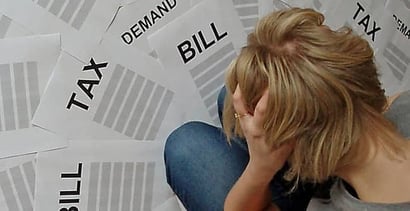

If you’re one of the millions of Americans with more debt than you can comfortably handle, paying down that debt can seem like you’re fighting a losing battle.
As a nation, Americans hold a total of more than $11 trillion dollars in combined consumer debt. The majority of that debt, around $8 trillion, is mortgage loan debt on our homes.
However, the next largest chunk is student loan debt at $1 trillion, followed by credit card and auto loan debt, each at around $800 billion.
It’s safe to say Americans as a whole are swimming in debt — or perhaps drowning is a better analogy. So what can we do about it?
This guide is intended to show those who are serious about getting rid of debt exactly how it can be done.
If you’re ready to make the tough choices and start down the road to responsible spending, I’ll show you how to get rid of debt.
1. Get a handle on your financial situation.
Most people who are in debt will avoid looking at their finances — it’s just too depressing! Of course, this isn’t a solution.
Instead, take a close look at what your monthly income and expenses add up to. This means looking at your paycheck, your savings, your debts and obligations, your discretionary spending…all of it.
Only then can you begin the process of getting rid of the debt.
2. You’re going to have to cut your spending.
It’s one of the basic laws of finance that in order to have more money (to pay down the debt), you’ll have to reduce your outflow (cutting your spending).
This can be done in numerous ways, but the best place to start is with eliminating the nonessential expenses in your life.
These can include indulgences like daily trips to Starbucks, premium cable channels, expensive trips to the salon and any service you could otherwise do yourself.
Begin making a habit of cutting out all unnecessary spending — you will be amazed at the “extra” money that will generate each month.
“By changing your patterns of
spending, you can change your life.”
3. Aggressively cut your debt.
This means developing a plan that prioritizes your payments based on the best value for each dollar you’re paying out. This means paying down high interest credit card debt first.
It also means focusing your resources on eliminating the debt accumulated on all credit cards – one at a time.
You will make the biggest payment possible on the highest interest card and then work down the list. As you pay off a card, direct that entire amount to the next one and so on.
4. Feeling better about your financial situation.
This is a crucial time in the process of getting rid of debt. Many people who get this far now reach a point of wanting to reward themselves.
Now don’t get me wrong, I have nothing against rewards for the sacrifices that have been made so far.
However, you must resist the temptation to return to old habits. Any rewards should be modest and within your budget.
There’s no use beginning the cycle of debt all over again. Think of things that hold their value and will contribute positively to your life for years to come.
5. Start building a solid savings plan.
By using the money you had been spending just on interest payments, your savings should grow rather nicely.
Put some of it into a regular savings account for emergencies while also diverting money into a retirement plan.
If you’re lucky enough to work for a company with a 401(k) plan that offers matching contributions, you should take full advantage of it.
If not, then contribute to a personal IRA that’s invested in low-cost, balanced funds.
By following these guidelines, anyone can get themselves off of the vicious treadmill of consumer debt.
It won’t be easy and won’t happen overnight, but if you’re committed to getting rid of debt, it will happen.
By changing your patterns of spending and accumulating debt, you can literally change your life. Instead of paying others with your hard-earned money, you’ll be paying yourself.
And that, my friends, is the best reward of all.
Photo source: chellascommoncents.com.
Advertiser Disclosure
BadCredit.org is a free online resource that offers valuable content and comparison services to users. To keep this resource 100% free for users, we receive advertising compensation from the financial products listed on this page. Along with key review factors, this compensation may impact how and where products appear on the page (including, for example, the order in which they appear). BadCredit.org does not include listings for all financial products.
Our Editorial Review Policy
Our site is committed to publishing independent, accurate content guided by strict editorial guidelines. Before articles and reviews are published on our site, they undergo a thorough review process performed by a team of independent editors and subject-matter experts to ensure the content’s accuracy, timeliness, and impartiality. Our editorial team is separate and independent of our site’s advertisers, and the opinions they express on our site are their own. To read more about our team members and their editorial backgrounds, please visit our site’s About page.




